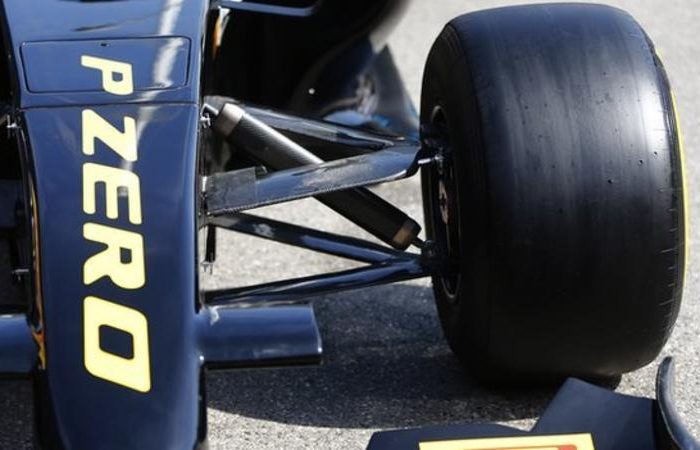



The 2017 season will see a return to wider cars and fatter tyres
FORMULA 1 will look very different when it emerges from its winter hibernation in 2017 – and not just because for the first time in 23 years the reigning world champion will not be racing.
Nico Rosberg’s decision to retire after winning his first world title not only left Mercedes with an awkward hole to fill alongside Lewis Hamilton, it means the German will not get the chance to drive new cars that are aimed at reinvigorating the sport.
Teams are faced with a radically revamped set of rules that will lead to faster, more dramatic-looking machinery.
Cars will be wider, with big, fat tyres, and reshaped front and rear wings. In theory, drivers will be tested physically in a way they have not been for nearly a decade.
The idea is to inject a bit of edge and rawness that some feel F1 has lost in the past few years – and hopefully end three years of Mercedes domination.
So, will it work?
The plan with the new rules is to make cars up to five seconds a lap faster and test the drivers physically more than they have been since Pirelli tyres entered F1 in 2011.
A number of changes have been made:
The result could be dramatic. In October, governing body the FIA compiled information about the downforce gains made by all the teams. The average gain was 15%; the most was 31%.
And senior insiders say downforce gains could reach 40% by the end of the year.
The effect of this will be vastly increased cornering speeds, especially in high-speed bends. Engineers talk about 130mph corners becoming 150mph; some bends that were not flat-out on the throttle will be. Cornering forces will be going up – perhaps by as much as 1G in fast corners.

The FIA’s target was to make overtaking no more difficult than it already was, and the combination of increases to aerodynamic and mechanical grip was calculated on that basis.
But the fear in some quarters is that the new cars could reduce overtaking.
The wider cars and tyres mean the cars will produce more drag, so be slower in a straight line, and cornering speeds will be higher. So braking distances will inevitably be reduced – which automatically makes overtaking harder.
Mercedes F1 boss Toto Wolff, who was opposed to the rule changes, says: “I hope that overtaking is not going to be too difficult because of the width of the car and the dirty air behind it – but let’s see.”

Most of the attention on the new tyres has been focused on their increased size. But far more important is the fact that supplier Pirelli has been asked to change the way they behave.
For the past six years, F1 tyres have had high ‘thermal degradation’ – they over-heat when drivers push hard and never recover their grip. So drivers had to lap at least a second, and sometimes much more, under the limit to coax out optimum stint lengths.
But producing much faster cars aimed at stretching the drivers is largely pointless if the drivers cannot race them on the limit.
As McLaren’s Fernando Alonso says: “We know they will be four or five seconds quicker. But if it is four or five seconds quicker on the first lap and then two seconds quicker the second lap, it is not fun anymore.”

As a result, Pirelli has been given a specific set of requirements for the new tyres.
These are contained in a ‘target letter’ and are: tyres must not overheat irrecoverably when a driver is following another car; degradation must be proportional to performance.
The FIA believes these stipulations will ensure that the need for management by driving under the limit to control thermal degradation is greatly reduced, and drivers can therefore push hard throughout a race.
In return, Pirelli asked for a series of test days through last season to develop the tyres.
Has it worked? The jury remains out. Pirelli did more than 12,000km of testing with ‘mule’ cars provided by Mercedes, Ferrari and Red Bull aimed at simulating the increased downforce levels of the 2017 cars.
The teams were only partially successful with the cars – they had only about 10% more downforce, were much heavier than they will be, and the engines considerably less powerful. But Pirelli said it was “encouraged” by the progress it was able to make.

After a final tyre test in Abu Dhabi following the last race of the 2016 season, Mercedes’ Lewis Hamilton and Red Bull’s Daniel Ricciardo were asked how the new tyres felt.
Hamilton said: “They are just pretty much the same tyre, just more grip. I didn’t really get a massive feel for it. More grip is always a good thing but I only did about eight laps. Daniel will have a much better read to give you.”
Ricciardo added: “The tyres felt a bit stronger. The rear mainly – you can push a bit harder on traction. We were running the cars quite heavy and I don’t think it is going to be that representative. I think [the cars] will be a step quicker. Some people talked four or five seconds. I’m sure they will be at least two seconds but four or five would be impressive.”
The target letter is part of Pirelli’s new deal with F1 until 2019. So if the tyres do not behave as specified, the company would technically be in breach of contract. That could potentially lead to some difficulties.
The chassis and tyre rules are not the only things changing – restrictions on engine development have also been relaxed.
The complicated ‘token’ system that limited the amount of changes allowed to engines in a season has been dropped. Now, the only restrictions are that any developments can be introduced only with a new engine – and teams are still limited to four engines in a season.
The hope is that removing restrictions on development will allow other manufacturers to close up on Mercedes, who still led the field in 2016.

Over Ferrari, Mercedes’ advantage was small – no more than 10bhp, perhaps much less. But Renault, who supply Red Bull, were 40-50bhp behind and Honda somewhere in the region of 60-100bhp.
Both Honda and Renault are producing pretty much all-new engines for 2017 and are targeting matching Mercedes. But development is also freed up for Mercedes – so it’s not impossible they could maintain or even extend their advantage.
The rule changes were pushed through, against opposition by Mercedes, because rivals felt it would give them the chance to close up on the world champions, who have dominated F1 since the start of the hybrid engine formula in 2014.
Mercedes argued in vain that the best way to close up the field was to leave the rules alone because, as Wolff puts it, “it’s clear that when regulations stay stable that eventually performance is going to converge”.
Rivals saw this as Mercedes protecting their competitive position – and the new rules as an opportunity to close the gap by providing a reset for everyone.
Red Bull were particularly vocal about this, team boss Christian Horner arguing that F1 needed to make the cars faster and harder to drive to stem a perceived drop in interest.
Horner said: “It will make the cars more dramatic, and more challenging for the drivers to drive.
“It is not a totally clean sheet of paper but it is a significant change, and that will maybe shuffle the order up a bit.”

The fact that audience figures were dropping largely because of the shift to pay TV was quietly ignored by many, or dismissed with claims that the sport needed to be made more obviously dramatic anyway.
But there is one big risk. Mercedes have produced the best car of the past three years, as well as the most powerful and efficient engine.
Some argue that the new rules actually enhance the importance of engine power because the wider cars produce so much more drag. And if you give the best team of the past three years, with the most powerful engine, a set of new rules of this ilk, then there is a real risk their advantage will increase, not decrease.
If that happens, some very serious questions will be asked about the decisions that were made, forcing teams into spending millions developing and building a new type of car only to make F1 worse.
“We weren’t big supporters of a regulation change,” Wolff says. “Not because we wanted to freeze the current situation but because we weren’t sure that it is the right way for Formula 1.
“But we are where we are and the cars, certainly in the wind tunnel, look very spectacular, very wide with the big tyres, and I am personally very excited to see them on track for the first time.
“For the drivers it will be much harder; the cars will be pulling more G-force through the corners.
“The simulations that we have seen are very exciting. Corners will be flat that are far from flat today – and we will be breaking records in terms of lap time.
“So, I guess, an exciting season will be ahead of us.
“Now that we are where we are, we have to make the best of it.” bbc.co.uk
